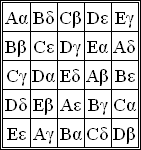Graeco-Latin square
In combinatorics, a Graeco-Latin square or Euler square or orthogonal Latin squares of order n over two sets S and T, each consisting of n symbols, is an n×n arrangement of cells, each cell containing an ordered pair (s,t), where s is in S and t is in T, such that every row and every column contains each element of S and each element of T exactly once, and that no two cells contain the same ordered pair.
- Orthogonal Latin squares
 Order 3
Order 3 Order 4
Order 4 Order 5
Order 5
The arrangement of the s-coordinates by themselves (which may be thought of as Latin characters) and of the t-coordinates (the Greek characters) each forms a Latin square. A Graeco-Latin square can therefore be decomposed into two "orthogonal" Latin squares. Orthogonality here means that every pair (s, t) from the Cartesian product S×T occurs exactly once.
History
Orthogonal Latin squares have been known to predate Euler. As described by Donald Knuth in Volume 4A, p. 3, of TAOCP, the construction of 4x4 set was published by Jacques Ozanam in 1725 (in Recreation mathematiques et physiques) as a puzzle involving playing cards. The problem was to take all aces, kings, queens and jacks from a standard deck of cards, and arrange them in a 4x4 grid such that each row and each column contained all four suits as well as one of each face value. This problem has several solutions.
A common variant of this problem was to arrange the 16 cards so that, in addition to the row and column constraints, each diagonal contains all four face values and all four suits as well.
According to Martin Gardner, who featured this problem in his November 1959 Mathematical Games column, the number of distinct solutions was incorrectly stated to be 72 by Rouse Ball. This mistake persisted for many years until the correct value of 144 was found by Kathleen Ollerenshaw. Each of the 144 solutions has eight reflections and rotations, giving 1152 solutions in total. The 144×8 solutions can be categorized into the following two equivalence classes:
| Solution | Normal form |
|---|---|
| Solution #1 | A♠ K♥ Q♦ J♣ Q♣ J♦ A♥ K♠ J♥ Q♠ K♣ A♦ K♦ A♣ J♠ Q♥ |
| Solution #2 | A♠ K♥ Q♦ J♣ J♦ Q♣ K♠ A♥ K♣ A♦ J♥ Q♠ Q♥ J♠ A♣ K♦ |
For each of the two solutions, 24×24 = 576 solutions can be derived by permuting the four suits and the four face values independently. No permutation will convert the two solutions into each other.
The solution set can be seen to be complete through this proof outline:
- Without loss of generality, let us choose the card in the top left corner to be A♠.
- In the second row, the first two cells can be neither ace nor spades, due to being on the same column or diagonal respectively. Therefore, one of the remaining two cells must be an ace, and the other must be a spade, since the card A♠ itself cannot be repeated.
- If we choose the cell in the second row, third column to be an ace, and propagate the constraints, we get Solution #1 above, up to a permutation of the remaining suits and face values.
- Conversely, if we choose the (2,3) cell to be a spade, and propagate the constraints, we get Solution #2 above, up to a permutation of the remaining suits and face values.
- Since no other possibilities exist for (2,3), the solution set is complete.
Euler's conjecture and disproof
Orthogonal Latin squares were studied in detail by Leonhard Euler, who took the two sets to be S = {A, B, C, …}, the first n upper-case letters from the Latin alphabet, and T = {α , β, γ, …}, the first n lower-case letters from the Greek alphabet—hence the name Graeco-Latin square.
In the 1780s Euler demonstrated methods for constructing Graeco-Latin squares where n is odd or a multiple of 4. Observing that no order-2 square exists and being unable to construct an order-6 square (see thirty-six officers problem), he conjectured that none exist for any oddly even number n ≡ 2 (mod 4). The non-existence of order-6 squares was confirmed in 1901 by Gaston Tarry through a proof by exhaustion. However, Euler's conjecture resisted solution until the late 1950s.
In 1959, R.C. Bose and S. S. Shrikhande constructed some counterexamples (dubbed the Euler spoilers) of order 22 using mathematical insights. Then E. T. Parker found a counterexample of order 10 using a one-hour computer search on a UNIVAC 1206 Military Computer while working at the UNIVAC division of Remington Rand (this was one of the earliest combinatorics problems solved on a digital computer).
In April 1959, Parker, Bose, and Shrikhande presented their paper showing Euler's conjecture to be false for all n ≥ 10. Thus, Graeco-Latin squares exist for all orders n ≥ 3 except n = 6.
Applications
Graeco-Latin squares are used in the design of experiments, tournament scheduling, and constructing magic squares. The French writer Georges Perec structured his 1978 novel Life: A User's Manual around a 10×10 Graeco-Latin square.
Mutually orthogonal Latin squares
A set of Latin squares is called mutually orthogonal if each Latin square in the set is pairwise orthogonal to all other Latin squares of the set.
| fjords | jawbox | phlegm | qiviut | zincky |
| zincky | fjords | jawbox | phlegm | qiviut |
| qiviut | zincky | fjords | jawbox | phlegm |
| phlegm | qiviut | zincky | fjords | jawbox |
| jawbox | phlegm | qiviut | zincky | fjords |
The above table shows four mutually orthogonal Latin squares of order 5, representing respectively:
- the text: fjords, jawbox, phlegm, qiviut, and zincky
- the foreground color: white, red, lime, blue, and yellow
- the background color: black, maroon, teal, navy, and silver
- the typeface: serif (Georgia / Times Roman), sans-serif (Verdana / Helvetica), monospace (Courier New), cursive (Comic Sans), and fantasy (Impact).
Due to the Latin square property, each row and each column has all five texts, all five foregrounds, all five backgrounds, and all five typefaces. These properties may be thought of as dimensions along which a value may vary.
Due to the mutually orthogonal property, there is exactly one instance somewhere in the table for any pair of elements, such as (white foreground, monospace), or (fjords, navy background) etc., and also all possible such pairs of values of distinct "dimensions" are represented exactly once each.
The above table therefore allows for testing five values in each of four different "dimensions" in only 25 observations instead of 625 (= 54) observations. Also note that the five 6-letter words (fjords, jawbox, phlegm, qiviut, and zincky) between them cover all 26 letters of the alphabet at least once each. The table therefore allows for examining each letter of the alphabet in five different typefaces, foreground colors, and background colors.
Due to a close relation between orthogonal Latin squares and combinatorial designs, every pair of distinct cells in the 5x5 table will have exactly one of the following properties in common:
- a common row, or
- a common column, or
- a common text, or
- a common typeface, or
- a common background color, or
- a common foreground color.
In each category, every cell has four neighbors (four neighbors in the same row with nothing else in common, four in the same column, etc.), giving 6 * 4 = 24 neighbors, which makes it a complete graph with six different edge colors.
The number of mutually orthogonal latin squares
The number of mutually orthogonal Latin squares (MOLS) that may exist for a given order n is not known for general n, and is an area of research in combinatorics. It is known that the maximum number of MOLS for any n cannot exceed (n - 1), and this upper bound is achieved when n is a power of a prime number. A set of n - 1 MOLS is equivalent to a finite projective plane of order n. The minimum is known to be 2 for all n except for n = 2 or 6, where it is 1. For general composite numbers, the number of MOLS is not known. The first few values starting with n = 2, 3, 4... are 1, 2, 3, 4, 1, 6, 7, 8, ... (sequence A001438 in the OEIS).
Orthogonal arrays
An orthogonal array of strength 2 and index 1 is a tabular form used to represent sets of MOLS. More general orthogonal arrays represent generalizations of the concept of MOLS, such as mutually orthogonal Latin cubes.
See also
Bibliography
- Raghavarao, Damaraju (1988). Constructions and Combinatorial Problems in Design of Experiments (corrected reprint of the 1971 Wiley ed.). New York: Dover.
- Raghavarao, Damaraju and Padgett, L.V. (2005). Block Designs: Analysis, Combinatorics and Applications. World Scientific.
- Street, Anne Penfold; Street, Deborah J. (1987). Combinatorics of Experimental Design. Oxford U. P. [Clarendon]. pp. 400+xiv. ISBN 0-19-853256-3.
Further reading
- Gardner, Martin (1966), Martin Gardner's New Mathematical Diversions from Scientific American, Fireside, pp. 162–172, 0-671-20913-2
External links
- Euler's work on Latin Squares and Euler Squares at Convergence
- Java Tool which assists in constructing Graeco-Latin squares (it does not construct them by itself) at cut-the-knot
- Anything but square: from magic squares to Sudoku
- Historical facts and correlation with Magic Squares, Javascript Application to solve Graeco-Latin Squares from size 1x1 to 10x10 and related source code (Javascript in Firefox browser and HTML5 mobile devices)